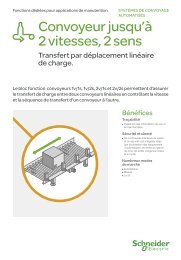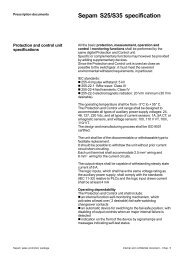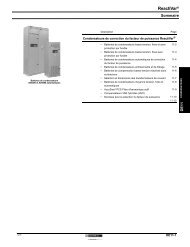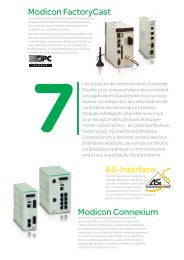Main Automation Contractor (MAC) — Targets ... - Schneider Electric
Main Automation Contractor (MAC) — Targets ... - Schneider Electric
Main Automation Contractor (MAC) — Targets ... - Schneider Electric
You also want an ePaper? Increase the reach of your titles
YUMPU automatically turns print PDFs into web optimized ePapers that Google loves.
<strong>Main</strong> <strong>Automation</strong> <strong>Contractor</strong><br />
(<strong>MAC</strong>) — <strong>Targets</strong> Long-Term<br />
Control System Access<br />
Best practices in engineering, procurement, and construction (EPC) —<br />
automated system contracting for critical hydrocarbon assets<br />
2012 / White paper<br />
Make the most of your energy SM
Summary<br />
Executive summary .................................................................................... p 1<br />
Introduction ................................................................................................ p 2<br />
What is a <strong>MAC</strong> project? ............................................................................. p 4<br />
Why the <strong>MAC</strong> approach? ........................................................................... p 5<br />
Benefits of a <strong>MAC</strong> approach ...................................................................... p 6<br />
<strong>MAC</strong> best practices .................................................................................... p 7<br />
Examples of <strong>MAC</strong> expertise at work — case study #1 .............................. p 10<br />
Examples of <strong>MAC</strong> expertise at work — case study #2............................... p 12<br />
Conclusion ................................................................................................. p 14
<strong>MAC</strong>—<strong>Targets</strong> Long-term Control System Success<br />
Executive summary<br />
The <strong>Main</strong> <strong>Automation</strong> <strong>Contractor</strong> (<strong>MAC</strong>) is the single, responsible contractor<br />
who works as a partner with the end user and manages the life cycle of the<br />
oil and gas operations automation solution. The <strong>MAC</strong> oversees the team of<br />
all suppliers and brings to the project both technology skills and real-world<br />
experience in integrating multiple systems—all vital in achieving the complete<br />
automation solution in an efficient and effective manner.<br />
The <strong>MAC</strong> is highly responsive to the end user’s vision, standards and choices;<br />
it embraces the ‘big picture’ view—targeting an automation solution that<br />
serves across the enterprise, for the long-term. Involving the <strong>MAC</strong> early in the<br />
project enforces reviews and approvals from all active suppliers and providers<br />
and assures appropriate compliance and certifications. The <strong>MAC</strong> applies best<br />
practices throughout engineering and design; testing and installation; start-up<br />
and maintenance—assuring each phase is ready to evolve to the next.<br />
As a result, the <strong>MAC</strong>-managed project yields a finely-tuned solution<br />
targeting operational and business success. In the process, the end<br />
user typically sees a 10 to 15 percent reduction in project costs and<br />
increased return on project investment.<br />
Two case studies are presented, each describing the comprehensive oil and<br />
gas control solution targeted, the responsibilities taken on by <strong>Schneider</strong><br />
<strong>Electric</strong> as project <strong>MAC</strong>, and the wide-ranging benefits delivered by the<br />
solution. For more than 25 years, <strong>Schneider</strong> <strong>Electric</strong>’s real-time automation<br />
control and information management solutions have enabled safe, secure<br />
and sustainable energy operations while optimizing business processes and<br />
profitability.<br />
Significant cost savings via <strong>MAC</strong>-managed projects<br />
White paper on EPC Best Practices | 01
<strong>MAC</strong>—<strong>Targets</strong> Long-term Control System Success<br />
Introduction<br />
Today, oil and gas operators deal with considerable tasks in designing,<br />
developing, and implementing critical infrastructures. Exacting regulations<br />
and industry standards, demanding project schedules, continuously updated<br />
technology, and constraining budgets combine to make successful project<br />
completion a challenge.<br />
Value can be provided by a <strong>MAC</strong>, who orchestrates the EPC tasks of<br />
implementing an advanced technology oil and gas process control system.<br />
With early involvement of an experienced <strong>MAC</strong>, the final automated system is<br />
fully integrated, meets appropriate standards, and is capable of making vital<br />
operational data available in real-time across the enterprise—enabling smarter<br />
decisions for safe, secure, and cost-effective operations. In this paper, we’ll<br />
include examples of automated process control system projects successfully<br />
completed using the <strong>MAC</strong> approach.<br />
White paper on EPC Best Practices | 02
Making permanent<br />
savings through best<br />
practices in engineering,<br />
procurement, and<br />
construction
<strong>MAC</strong> — <strong>Targets</strong> Long-term Control System Success<br />
What is a <strong>MAC</strong> project?<br />
Simply, the <strong>MAC</strong> manages the life cycle of the<br />
automated process control system project,<br />
including phases targeting:<br />
• Requirements (including security)<br />
• Design and construction<br />
• Testing<br />
• Release<br />
• Site acceptance<br />
• Warranty, support, and maintenance services<br />
• Project management<br />
As the single responsible contractor, the<br />
<strong>MAC</strong> operates as a partner with the end user<br />
and oversees a team of suppliers, fostering<br />
cooperation and understanding of overall project<br />
goals. The <strong>MAC</strong> assumes the risk for meeting<br />
project schedule and budget.<br />
White paper on EPC Best Practices | 04
<strong>MAC</strong> — <strong>Targets</strong> Long-term Control System Success<br />
Why the <strong>MAC</strong> approach?<br />
Increasing significance of technology — to remain<br />
agile in the increasingly complex energy market, oil<br />
and gas companies must automate vital functions<br />
such as collecting operational measurements,<br />
controlling critical infrastructure processes, and<br />
analyzing information for business insight. Working<br />
with a central automation expert who can integrate<br />
multiple applications required for accurate and<br />
reliable automation is an efficient alternative to<br />
relying on specialized vendors located worldwide.<br />
There is a reduction of 10<br />
to 15 percent in costs when<br />
the end user involves the<br />
automation contractor<br />
early in the project<br />
execution.<br />
Reduced margins — today’s markets are changing<br />
and business is much more competitive. Operators<br />
see pressure from all stakeholders to reduce<br />
operating costs.<br />
Need for reliable skills and expertise — staffing<br />
with in-house experts is expensive. In addition,<br />
staff retirees take with them thorough and intimate<br />
knowledge of their employer’s specific operations<br />
and process control.<br />
Targeted configuration — the <strong>MAC</strong> brings realworld<br />
experience to deliver a specific solution<br />
that can meet the end user’s exclusive automated<br />
system needs.<br />
White paper on EPC Best Practices | 05
<strong>MAC</strong> — <strong>Targets</strong> Long-term Control System Success<br />
Benefits of a <strong>MAC</strong> approach<br />
Reduction of cost and time —according to Frost<br />
and Sullivan, there is a reduction of 10 to15 percent<br />
in costs when the end user involves the automation<br />
contractor early in the project execution. <strong>MAC</strong>managed<br />
projects significantly reduce the time the<br />
end user spends dealing with multiple EPC firms<br />
and software vendors. Streamlined efforts reduce<br />
change orders and miscommunications—and<br />
controls costs.<br />
End user has control over the solution — the<br />
automation vendor is highly motivated and<br />
substantially more responsive to the end user’s<br />
vision, standards, and choices. The partner <strong>MAC</strong><br />
ensures that the automation system is consistent<br />
with the client’s vision as defined in the FEED<br />
(front-end engineering and design).<br />
High return on project investment — the <strong>MAC</strong><br />
project increases ultimate profits through reduced<br />
implementation costs, faster commissioning, and<br />
facilitated adaptations to meet future requirements.<br />
In summary, <strong>MAC</strong>-managed project investments<br />
are returned quickly, through:<br />
• Reduced project costs<br />
• Pre-start up tests that reduce commissioning<br />
problems or failure<br />
• Earlier go-live date<br />
• Precisely configured solution for targeted<br />
performance<br />
• Post-service support<br />
Finely tuned solution — the <strong>MAC</strong> evaluates all<br />
systems and installations, minimizing integration<br />
problems and assuring compliance to applicable<br />
standards, certifications, and guidelines.<br />
Ultimate operational and business success<br />
— dedicated and effective communication<br />
and planning between the end user and<br />
the experienced <strong>MAC</strong> partner results in an<br />
infrastructure that serves long-term goals, through<br />
scalability and extensibility.<br />
White paper on EPC Best Practices | 06
<strong>MAC</strong> — <strong>Targets</strong> Long-term Control System Success<br />
<strong>MAC</strong> best practices<br />
Front-End<br />
Engineering<br />
and Design<br />
Detailed<br />
Engineering<br />
Design<br />
Procurement<br />
of Systems<br />
Factory<br />
Acceptance<br />
Test<br />
Stages in a project execution process<br />
Installation<br />
and Site<br />
Acceptance<br />
Test<br />
Source: Frost & Sullivan<br />
Operation<br />
and<br />
<strong>Main</strong>tenance<br />
Figure 1:<br />
Typical Stages in<br />
<strong>Automation</strong> Project<br />
Execution<br />
<strong>MAC</strong> oversight enforces<br />
reviews and approvals<br />
from all active suppliers<br />
and providers, along with<br />
the end user, at each stage<br />
of the automation control<br />
system project.<br />
In the current automation market where major<br />
companies commoditize SCADA products, the<br />
<strong>MAC</strong>, instead, takes the ‘big picture’ view—<br />
embracing all phases of implementation and<br />
targeting a comprehensive monitoring and control<br />
solution that serves oil and gas companies from<br />
the field to the boardroom.<br />
<strong>MAC</strong> value chain<br />
The <strong>MAC</strong> oversees all phases of the automated<br />
control infrastructure life cycle, including<br />
engineering and design, procurement of systems,<br />
Factory Acceptance Test (FAT), installation and<br />
commissioning, Site Acceptance Test (SAT), startup,<br />
and maintenance. Working as a partner with<br />
the end-user, the <strong>MAC</strong> assures each phase is ready<br />
to evolve to the next, adding value throughout the<br />
project; see Figure 1, above.<br />
White paper on EPC best practices | 07
<strong>MAC</strong> — <strong>Targets</strong> Long-Term Control System Success<br />
<strong>MAC</strong> best practices (continued)<br />
Business<br />
Applications<br />
Advanced<br />
Applications<br />
for Operations<br />
Control<br />
Systems<br />
Field Devices<br />
Enterprise GIS<br />
OSIsoft ® PI<br />
SimSuite Simulator<br />
Liquids Suite<br />
Gas Suite<br />
OASyS DNA<br />
(Windows ® )<br />
OASyS UX (Unix)<br />
SAGE, Saitel,<br />
gasCAT<br />
CD Platform<br />
Figure 2:<br />
<strong>MAC</strong> best practice of<br />
enterprise-wide flow of<br />
information<br />
Real time operational<br />
data flows through the<br />
integrated solution,<br />
providing smart<br />
information — timely,<br />
validated, and complete —<br />
for business applications.<br />
Enterprise-wide utilization<br />
The <strong>MAC</strong>’s solution approach visualizes the longterm,<br />
flexible infrastructure rather than adopting<br />
a one-project focus. The resulting comprehensive<br />
automation solution serves the entire enterprise,<br />
integrating field devices and Remote Terminal Units<br />
(RTUs), supervisory control and data acquisition<br />
(SCADA), data analysis and process control<br />
applications, and advanced data management<br />
applications; see Figure 2, above. Each application<br />
runs on proven operating systems, yielding<br />
validated data, and offers built-in redundancy and<br />
security for reliable performance.<br />
White paper on EPC best practices | 08
<strong>MAC</strong> — <strong>Targets</strong> Long-term Control System Success<br />
<strong>MAC</strong> best practices (continued)<br />
State-of-the-art security<br />
The <strong>MAC</strong> will be knowledgeable of the security consequences of<br />
deploying control systems or applications from different vendors in the<br />
same environment. <strong>MAC</strong> experience with vendor-specific guidelines adds<br />
tremendous value in reducing cyber security risks for the end user’s project.<br />
Benefits are both tangible<br />
and creditable<br />
By committing to a power optimization<br />
program that allows documentation of<br />
energy usage and savings, a pipeline<br />
operator reduces electricity consumption<br />
and associated costs and emissions. This<br />
approach not only reduces bottom-line<br />
expenses, it also generates carbon credits<br />
that can be sold or traded on the open<br />
market per industry and/or government<br />
regulations or applied to help meet overall<br />
carbon footprint limits – and reap the<br />
marketing benefits of being a ‘green’<br />
organization and an environmental steward.<br />
White paper on EPC best practices | 09
<strong>MAC</strong> — <strong>Targets</strong> Long-term Control System Success<br />
Examples of <strong>MAC</strong> expertise at work<br />
Following are two case studies reflecting the value of the <strong>MAC</strong> in providing both technology<br />
and the experience needed to successfully manage a multi-disciplinary project.<br />
Case study 1: updated, central control of offshore oil<br />
and gas wellhead towers<br />
A leading company in oil and gas production owns<br />
concessions for two of the world’s largest offshore<br />
oil fields, located off the coast of the Middle East.<br />
The unmanned oils and gas wellhead towers in<br />
these fields, 63 in all, had been supervised by radio<br />
telemetry systems. Yet, the costs of spare parts to<br />
maintain the aging equipment of these systems,<br />
and limited expansion potential due to the aging<br />
technology employed, undermined the availability,<br />
security, and reliability of these control systems and<br />
field operations.<br />
The company sought a cost-effective, advanced<br />
technology control system that would facilitate<br />
safe and efficient operation of its upstream<br />
infrastructure. The full solution required multiple<br />
technologies and cooperative engineering—<br />
including the supply and installation of solar<br />
power units, remote terminal units (RTUs), digital<br />
radio communication, and a third-party Distributed<br />
Control System. The company chose to take<br />
advantage of <strong>Schneider</strong> <strong>Electric</strong>’s extensive<br />
experience in comprehensive development of<br />
automated systems and named the firm as project<br />
<strong>MAC</strong>.<br />
<strong>Schneider</strong> <strong>Electric</strong> provides overall management<br />
and responsibility for the project from its local<br />
corporate office in the U.A.E., coordinating the<br />
entire automation process through engineering and<br />
design, sub-contracting third-party systems, FAT,<br />
SAT, commissioning, start-up, and post-project<br />
maintenance. This approach assures that each<br />
component of the integrated solution is tested and<br />
ready for system go-live, minimizing project rework,<br />
time, and costs.<br />
Single-face solution<br />
In the Middle East, two of<br />
the world’s largest offshore<br />
oil fields gain the flexibility<br />
and scalability needed<br />
to serve at least 15 years<br />
through a full automation<br />
solution that requires<br />
multiple technologies and<br />
cooperative engineering.<br />
<strong>Schneider</strong> <strong>Electric</strong> is upgrading and installing<br />
a state-of-the-art OASyS DNA SCADA at the<br />
control centers of the two platforms to support<br />
multi-protocol telemetry communications. It is<br />
interfacing the SCADA with a Distributed Control<br />
System (DCS) for process control and with an<br />
offline engineering workstation at the company’s<br />
headquarters.<br />
White paper on EPC best practices | 10
<strong>MAC</strong> — <strong>Targets</strong> Long-term Control System Success<br />
Case study 1: updated, central control of offshore<br />
oil and gas wellhead towers (continued)<br />
The solution being created with <strong>Schneider</strong> <strong>Electric</strong><br />
as the <strong>MAC</strong> will provide:<br />
• The flexibility and scalability needed to serve<br />
at least 15 years of the company’s extraction<br />
operation<br />
• High integration capabilities with third-party<br />
protocols and systems<br />
• Common technology applied across both fields,<br />
making resource utilization and production<br />
efficient<br />
• The highest level of security for the oil company’s<br />
assets<br />
• Optimized operations that support cleaner energy<br />
and a safer environment<br />
White paper on EPC best practices | 11
<strong>MAC</strong> — <strong>Targets</strong> Long-term Control System Success<br />
Case study 2: Centralized control and<br />
management of oil and electric processes<br />
An oil exploration company operating in the<br />
Amazon district of Latin America produces<br />
approximately 62 million barrels of crude oil per<br />
year. This production amounts to a daily average<br />
of more than 170,000 barrels.<br />
The company looked to improve cost efficiency and<br />
reliability of the internal electrical power generation<br />
and distribution operations that supply its oil<br />
exploration and production activities—guaranteeing<br />
continuous power supply where and when needed.<br />
It also aimed to optimize crude oil extraction,<br />
transportation, and production processes; implement<br />
security enhancements; and control impacts on its<br />
operating environment in the Amazon region.<br />
Single-face solution<br />
In Latin America, a major<br />
producer of oil (62 million<br />
barrels of crude per year)<br />
looks for cost efficiency<br />
and reliability of its oil and<br />
electric processes through<br />
an integrated multi-utility<br />
solution.<br />
The company selected <strong>Schneider</strong> <strong>Electric</strong> for a<br />
single-face solution for preliminary and detailed<br />
engineering, development of an OASyS SCADA<br />
system, implementation and testing, and operational<br />
start-up. <strong>Schneider</strong> <strong>Electric</strong> managed SCADA<br />
interface with applications operating among electric<br />
substations, generation centers, production wells,<br />
and crude oil production stations:<br />
• The Life of Well Information System, collecting<br />
well data for the real-time analysis and control to<br />
maximize production while extending the well’s<br />
useful life<br />
• <strong>Schneider</strong> <strong>Electric</strong>’s real-time Distribution<br />
Management System (DMS) for efficient electric<br />
operation<br />
• Automatic Generation Control System (AGC) and<br />
Economy Dispatching (ED) for a continuous and<br />
nearly instantaneous balance between power<br />
generation supply and load demand<br />
• <strong>Schneider</strong> <strong>Electric</strong>’s ArcFM Geographic<br />
Information System (GIS) for anytime access to the<br />
infrastructure geodatabase.<br />
White paper on EPC best practices | 12
<strong>MAC</strong> — <strong>Targets</strong> Long-term Control System Success<br />
Case study 2: Centralized control and<br />
management of oil and electric processes<br />
(continued)<br />
The turnkey system delivers real-time assets<br />
data and enables the company to automate and<br />
centralize supervision and control of both oil<br />
production and electric generation and distribution<br />
operations through a single, main control center.<br />
The turnkey system also incorporates remote<br />
terminal units (RTUs) and a backup control center<br />
to guarantee uninterrupted operation. Further,<br />
it has been integrated with a communication<br />
system that delivers 99.99percent accuracy of<br />
information transfer from the SCADA—and it can<br />
be integrated with the legacy system. Also as part<br />
of the overall solution, <strong>Schneider</strong> <strong>Electric</strong> managed<br />
the construction and equipping of the new building<br />
housing the <strong>Main</strong> Control Center.<br />
Through <strong>Schneider</strong> <strong>Electric</strong>’s <strong>MAC</strong> management,<br />
a solution was created to satisfy both short- and<br />
long-term company goals:<br />
• Providing a unique and highly integrated multiutility<br />
solution to efficiently manage electric and<br />
oil activity<br />
• Optimize production and well life of the system’s<br />
110 wells<br />
• Gain real-time accounting control and custody of<br />
oil produced across the company’s 35 facilities<br />
• Automate operation of the company’s seven<br />
electric generation plants—including dispatching<br />
activities, post-dispatching, and operative<br />
programming—from the main control center,<br />
through the AGC and DMS<br />
• Improve security<br />
• Access real-time information and historical data<br />
by region<br />
• Improve current and future planning capacity<br />
resulting in better business decision-making<br />
White paper on EPC best practices | 13
<strong>MAC</strong> — <strong>Targets</strong> Long-term Control System Success<br />
Conclusion<br />
<strong>MAC</strong> in a nutshell:<br />
• Oil and gas operators utilize the <strong>MAC</strong> to make certain the best technology is<br />
utilized and best practices are applied.<br />
• The <strong>MAC</strong> approach delivers a comprehensive solution that automates<br />
operations for both short- and long-term effectiveness.<br />
• The <strong>MAC</strong> approach streamlines business processes for efficiency<br />
and profitability.<br />
• <strong>Schneider</strong> <strong>Electric</strong> brings vital experience as a <strong>MAC</strong> in full-scope automation<br />
projects that integrate state-of-the-art hydrocarbon industry systems and<br />
support improved operations, revenue and sustainability.<br />
With <strong>MAC</strong>, the end user typically sees a 10 to 15<br />
percent reduction in project costs.<br />
White paper on EPC best practices | 14
<strong>Schneider</strong> <strong>Electric</strong> USA, Inc.<br />
10333 Southport Rd SW, Ste 200<br />
Calgary, AB T2W3X6<br />
Phone: 1-403-212-2407<br />
Fax: 1-403-259-2926<br />
www.schneider-electric.com/us<br />
998-1189133_GMA-GB<br />
February 2013<br />
©2013 <strong>Schneider</strong> <strong>Electric</strong>. All rights reserved.

















